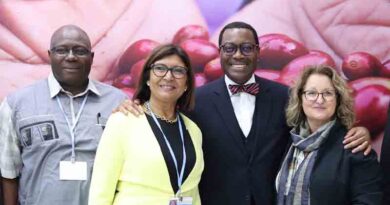Making purple maize a seed of prosperity for Peruvian farmers
13 October 2022, Mexico: In Mexico there is an indigenous poem that says, “We are grains of maize from the same cob; we are one root of the same path.” So, it is not surprising that the path of Alicia Medina Hoyos, a researcher with the National Maize Research Program at El Instituto Nacional de Innovación Agraria (INIA), began life in a rural community in Cupisnique, Cajamarca, Peru, at 1,800 meters above sea level.
At an early age, she realized the importance of maize as a feature of identity. This prompted her to dedicate her life to contribute to food security through research on starchy maize, soft maize types used for human consumption with 80% starch in their composition.
Medina studied Agronomy at the National University of Cajamarca, where her thesis brought her into contact with Luis Narro, a Peruvian researcher linked to the International Maize and Wheat Improvement Center (CIMMYT), which she has been associated with ever since.
“This permanent contact has been key to strengthening my capacities to actively participate in the co-creation of better opportunities for producers in Peru and Latin America,” said Medina. Her connection with CIMMYT has helped her to maintain an enriching exchange of knowledge and experiences with researchers such as Terry Molnar, a specialist in native maize, as well as with the more than 130 colleagues who make up the Latin American Maize Network.
It has also provided opportunities to showcase Peruvian agricultural research. In 2022, Peru hosted the XXIV Latin American Maize Meeting, an event jointly organized by CIMMYT and INIA every two years. Medina explained, “The event is a great opportunity to show Cajamarca, producers, organizations, to highlight the best we have, and to promote purple maize.”
Award-winning research
On International Women’s Day in 2019, Medina received an award from the College of Engineers of Peru for the effort, dedicated work, and contribution of engineering to the service of society.
When asked what it meant to receive this award, Medina said, “Research in starchy maize and, in recent years, in purple maize, has taken me to Ecuador, Colombia, Bolivia and Japan, and has given me the satisfaction of receiving awards that motivate me to continue putting research at the service of producers.”
This is without losing sight of the other valuable awards that Medina has received: the Personage of the Bicentennial, awarded in 2021 by the Provincial Municipality of Contumazá, Peru; the compass that Chile gave her in 2021 as recipient of the Strait of Magellan Award for Innovation and Exploration with Global Impact; and the SUMMUM Research Award given by the Summum Awards Advisory Committee in 2019.
Why is purple maize so important?
Purple maize comes from a breed called kulli. The team of researchers led by Medina — who obtained the variety — brought a population of purple maize from Huaraz, Peru, and crossed it with another from Cajamarca. Ten years of breeding gave rise to the INIA 601 maize, characterized by its high yield and high content of anthocyanins and antioxidants that are beneficial to health, cancer prevention, and lowering high blood pressure and cholesterol.
“In 2011 I had the opportunity to go to Japan, followed by working with a team of Japanese experts in Cajamarca,” explained Medina. “There, we started a project that gave more importance to purple maize, not for its production but for its color and therefore anthocyanin content. We saw the characteristic of the color in the husk. In 2013, we determined the amount of anthocyanin in this variety and it turned out that it was higher in the husk than in the cob. That gave us the option to market both parts.”
Medina explains how teamwork with the Japan International Cooperation Agency (JICA) laid the foundations so that today, 500 Peruvian producers “who see that there are profits, are convinced, by listening to their testimonies, in dissemination and training events” grow the maize in 12 of the 13 provinces that make up Cajamarca and market a kilo of cob and purple maize bract at $5 USD each.
There is currently high demand for the product in grain, grain flour, whole, dried, chopped and chopped dried forms; transnational companies based in Lima acquire the purple maize to extract the pigment and anthocyanin, and export it to the United States, Japan and Spain. “In fact, there are companies that produce whiskey with purple maize flour from Cajamarca,” Medina added.
In October 2021, a new agricultural campaign began in the Peruvian fields and Medina continues to promote agriculture based on the dream of seeing purple maize become a flagship product of the country, while becoming the engine of agribusiness in the region of Cajamarca, so that producers benefit in a better way, have more income and see the real magnitude of the grain they grow every day.
Also Read: Indian farmers are using less agrochemicals shows data for FY2021-22
(For Latest Agriculture News & Updates, follow Krishak Jagat on Google News)















